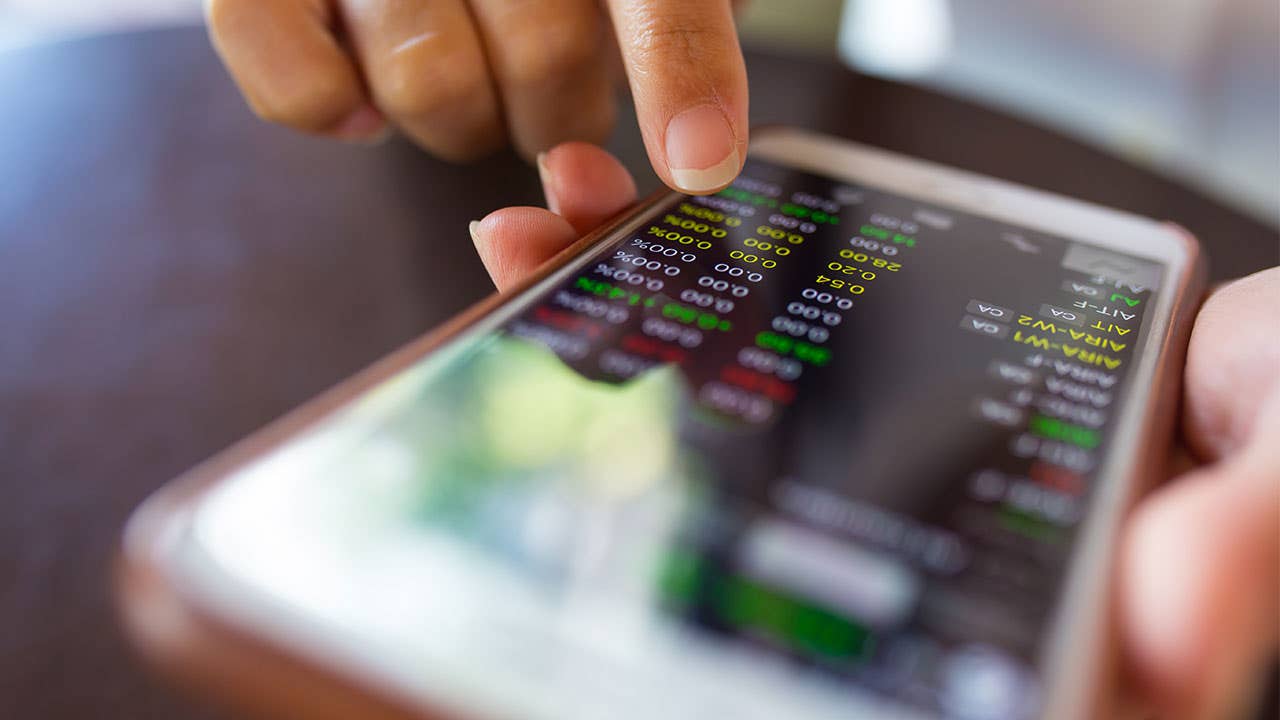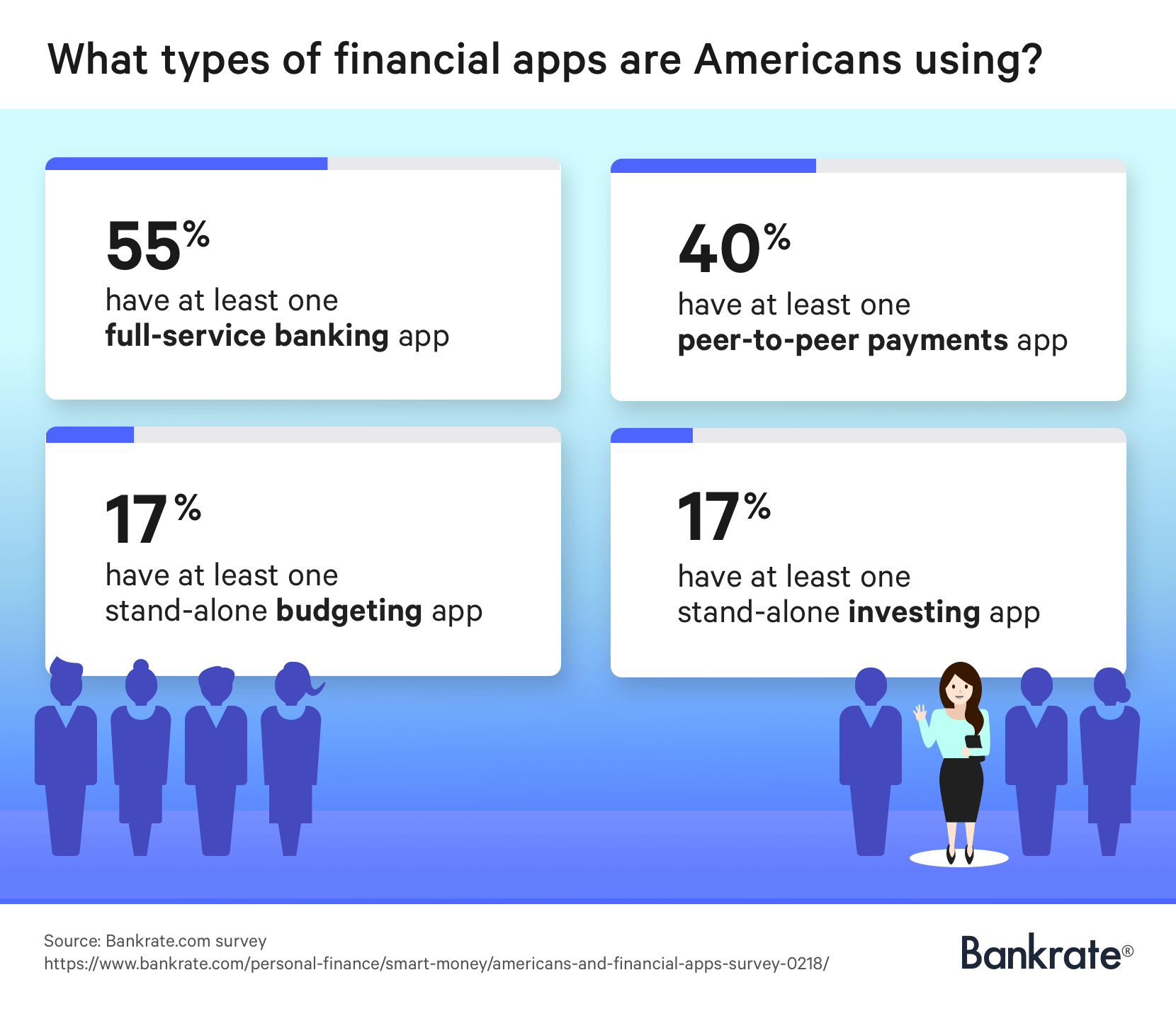63% of smartphone users have at least one financial app

The Bankrate promise
At Bankrate we strive to help you make smarter financial decisions. While we adhere to strict , this post may contain references to products from our partners. Here's an explanation for .
Among smartphone users in the U.S., nearly two-thirds have at least one financial app.
That’s according to a new survey by Bankrate that asked Americans about their use of finance-related apps, including those from traditional banks and fintech players.
In the decade or so since smartphones were introduced, people have largely embraced using their devices to keep tabs on their checking accounts and other products. That’s particularly true for banking apps, where 70 percent of the respondents say they check their bank’s mobile app at least once a week; 16 percent say they check it every day.

The benefits of engagement
Regular use of mobile banking apps has potentially significant implications for the financial health of users. Essentially, people now have the ability to see very quickly how much money they have and where it is going.
For instance, watching your available checking account balance regularly is key to avoiding overdrafts, says Greg McBride, CFA, Bankrate’s chief financial analyst.
“Using mobile banking makes you more aware of your current financial state — what payments have cleared, whether your paycheck has been direct deposited, whether or not there is a hold on the check you just deposited,” McBride says.
Users might also spot discrepancies or fraud faster on mobile than online. The ability to spot fraud quickly is just one of the elements that also makes mobile a more secure banking experience. Other elements include the use of biometrics, such as using your face or thumb to authenticate yourself, which are fundamentally stronger tools than using a password.
The frequency with which people are using their banking apps also further demonstrates how intertwined devices have become in our lives, says Raja Bose, global retail banking consulting lead at consulting firm Genpact. Bose was an executive at Bank of America in the early years of mobile banking.
“Back then, we described active mobile users as those who were active at least once in the last 30 days,” Bose says. “That underlines the point that frequency is being viewed in smaller windows of time.”
Mobile banking 2.0
The frequency that people use mobile banking should also lead to cooler features.
Banks first introduced mobile banking with straightforward features that mimicked what they offered online. But banks quickly learned that mobile is more dynamic than a desktop and have rolled out additional tools that wouldn’t be practical for the average user online.
The best example of this is the ability to deposit a check by snapping a quick photo of it, which began gaining widespread adoption in 2013.
With critical mass in mobile, banks are now looking at how they might evolve their apps from another way to interact with the bank to the cornerstone of your experience with your bank.
“The overall share of banking customers adopting mobile has plateaued, and one of the reasons that is the case is that until the last two or three years mobile banking has been essentially mobile customer support,” Bose says. “But increasingly, the more progressive institutions are adding more functionality over and above what is offered on other channels.”
In the future, your bank’s app could help you comparison shop, tell you when you’re blowing your budget or tell the teller who you are and likely why you’re visiting when you go into a branch.
Michelle Moore, who oversees digital banking for Bank of America, sees the road to getting the people you see on their smartphones in line at the branch to use mobile banking a little differently.
“People who don’t use mobile banking don’t understand all the capabilities,” Moore says. “So to us, the opportunity is education, education, education.”
Bank of America has taken a note from Apple’s genius bar at its stores and retrained 4,500 of its branch employees to be digital ambassadors — essentially people there to answer all of your digital banking questions.
Mobile use among the generations
It’s easy to think of mobile banking as primarily a millennial thing, but the adoption rates among the generations were fairly comparable: 64 percent of millennials and 59 percent for Gen Xers said they have at least one full-service banking app on their phone, though only 41 percent for respondents age 55 and up said the same.
In the other categories, such as budgeting, investing or payments apps, the generational factors played more prevalently, however. For instance, 34 percent of those between the ages of 18 and 34 say they have at least one budgeting app on their phone. By contrast, only 15 percent of those 35 to 54 say they have at least one.
What is also noteworthy is the adoption of investing apps like Betterment by people between the ages of 18 and 34. The survey found that 31 percent say they have at least one investing app on their phone.
An expected $30 trillion is expected to be transferred millennials as they inherit their parents’ and grandparents’ money. When that happens, where they will put it is a major point of interest for the traditional wealth managers. Will they stick with the robo-advisory firm that charged them low fees when all they could afford to invest was, say, $50 a month? Or will they go where their parents banked? This question is what is prompting several banks and wealth managers to come up with a robo-adviser solution. For instance, Morgan Stanley launched its Access Investing robo platform in December.
McBride says the actual transfer of wealth might be significantly less than expectations, given increased life spans, rising health care costs and a lack of retirement preparedness. Still, wealth managers are justifiably worried.
“The money management and financial planning industry has broken out in a cold sweat about the potential assets that could go walking out the door as oftentimes the adult children have no loyalty to the adviser their parents used,” McBride says. “The Charles Schwab ‘Dad, the world is changing‘ commercial touches on this.”
Related Articles



80% of financial app users admit not fully realizing their banking credentials are shared: Survey

Just 38% of Americans say their finances have improved since the 2016 election